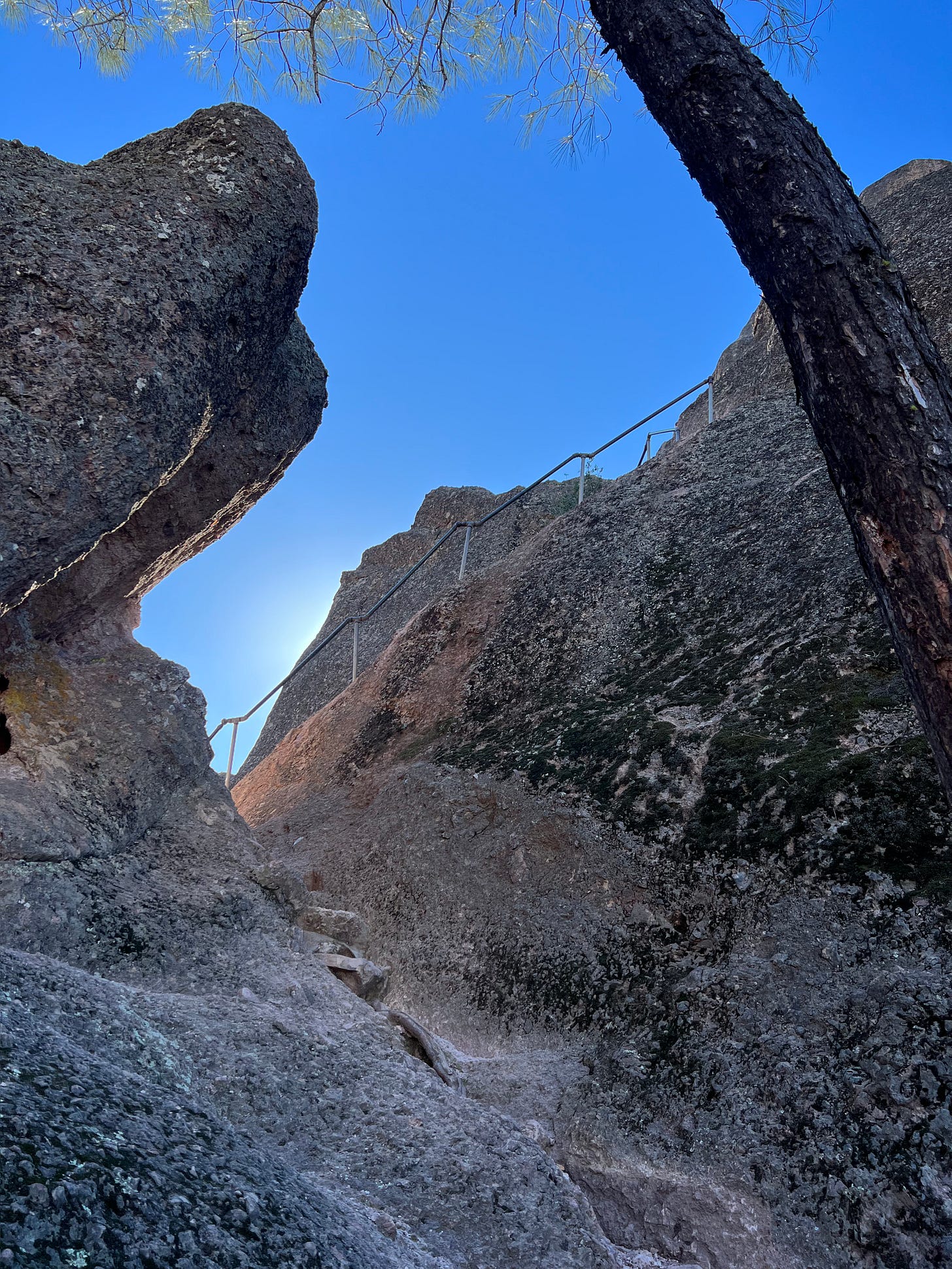The High Peaks
Twenty-three million years after the Neenach Volcano erupted, splashing lava across an otherwise unremarkable range of mountains, I scrambled up to the heights of the High Peaks, the remnants of that ancient explosion, and marveled at how otherworldly this place — Pinnacles National Park — truly is.
Only a sliver of the moon hung in the morning sky as I slipped out of the city, pirouetting through traffic at the 101 interchange that, just after 6:45 a.m., was already remarkably chaotic. I’d only settled on hiking the High Peaks and Balconies Cave Loop Trail at 10 p.m. the night before. Originally, ambitiously, I’d wanted to climb to the top of the Upper Yosemite Falls Trail. But the winter conditions compounded by my lack of proper gear — most notably microspikes and trekking poles — threatened to escalate the hike to the top of North America’s tallest waterfall from objectively challenging to wildly dangerous.
Almost four months to the day from my first visit to the park, I drove through the West entrance only to realize there was no one at the kiosk and the visitor center was closed. Pinnacles is the greatest national park that no one seems to talk about, never mind visit or staff. Over the summer Allison and I had stopped at the park — also in impromptu fashion on the way home from a wedding near the Central Coast — entering through the West gate. We tempted the August sun, climbing up to the Condor Gulch Overlook and even made it to the stunning Bear Gulch Reservoir — the iconic reddish orange pinnacles looming above one side of the shore — by way of a cave.
Today, thanks to the magic of plate tectonics, Pinnacles sits 195 miles northwest from the now-extinct volcano that spawned it. That’s quite the distance until you consider the perspective. The Pacific Plate, which split the rock that we know call the Pinnacles off from the main volcano, is the largest tectonic plate in the world at 40 million square miles. So, what’s a little 195-mile nudge?
As I began the ascent up to the High Peaks, the switchbacks snaking up from the valley, it felt entirely too easy to get distracted by the views and wander off a cliff. Just before reaching one of the highest points along the ridge, AllTrails sent me up a side path of loose gravel that climbed to a height north of 2,500 feet. To the left of the rocky crown was a wooden barrier that reminded me of the split rail fences I’d seen at Jockey Hollow — the famous Revolutionary War winter camp. Strung to the top of the fence by metal wiring was a tiny sign warning to stay out.
“Restoration Area-No Shortcutting
Maximum Fine of $5000 and 6 Months in Jail…”
Left unsaid was the fact that ignoring this sign would almost certainly result in tumbling over 1,000 feet to the valley floor.
To make it through the High Peaks Trail, you have to navigate a series of staircases — carved directly into the stone — and negotiate a wooden walkway wedged between two giant rocks. At points, the climb is all but vertical — made possible only by the assistance of a thin metal rail. In wet or icy conditions, passage would be out of the question.
After the thrill, the exhilaration of the High Peaks, the middle part of the hike is a bit of a drag. As I zipped down the slope, I left behind the fantastic, unusual stone towers, but not, it turns out, the danger.
Right before reaching the end of the loop — traveling along a trail which, inexplicably, crossed over the same stream seven times — two stone walls rise up on either side, creating an impressive valley. To one side is the Machete Ridge Destiny Wall Area — an ominous name — which soars 700 feet up from the creek bed. Improbably, as I looked up, I saw two climbers standing on the summit, who, at that particular moment, were not secured by a single rope. I wondered how exactly they would repel back down. On the other side is the Balconies Cave, hidden beneath a considerable rock formation.
Initially, I’d circumvented the cave by following a trail above it, but I’d always planned to double back. I walked through the metal gates, an enormous boulder poised overhead, wedged between rocks walls on either side, arresting its fall. Almost immediately, the cave seemed to dead end. I was lost. Then I noticed the tiny white arrow painted on the side of the rock pointing down into the earth. Terrifying, I thought.
So, down I went. The floor, sloping into the abyss, was wet and slick. The cave was fully dark. So, I tried to use my iPhone flashlight but that left me with just one hand to steady myself against the rock. Hunched over to keep myself from falling (or hitting my head on the overhanging ceiling), I noticed another little arrow — this one pointing up, right back where I’d came from. It was cold. I was tired, and, to put it candidly, this cave scared the shit out of me. I couldn’t plunge any further. Instead, I hurried back to the surface. I couldn’t get out of there fast enough. Sometimes, adventures are best left behind.








